
|
 |
|
Last Updated: Aug 16th, 2006 - 11:01:00 |

This article will provide a basic overview of just about all of the different types of rear suspensions that have been used on production and racing vehicles since the inception of the automobile. While some of the older styles are obsolete it is still important to learn about them because it provides valuable insight into why the cutting edge suspensions of today perform so much better.
Just like the evolution of the front suspension, rear suspension designs became more sophisticated as the race and road going car evolved. On noticeable difference between front and rear styles of design is that as front suspensions were developed the older styles were phased out. Not necessarily so with rear suspensions. Up until very recently even sports cars featured the older live rear axle setup. This article will cover the many different types of rear suspensions found on front, rear, and all-wheel drive vehicles. In our overview of rear suspensions, we will start with rear wheel drive vehicles and begin with the many variants of the live rear axle.
Rear Wheel Drive (RWD) Rear Suspensions: Live Rear Axle
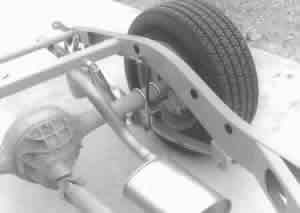 |
| In this image you can clearly see how the axle is supported and located by the leaf springs. |
The first style of live axle is the Hotchkiss rear axle design. This design was the primary rear suspension setup on domestic vehicles in the sixties and seventies and it is still used on the back end of pick up trucks. The Hotchkiss setup has the rear end located by a leaf spring on each side running fore and aft on the vehicle. The leaf springs also serve to support the weight of the vehicle and help condense the Hotchkiss suspension to a very simple system. While the basic Hotchkiss style is a direct carry over from horse drawn buggies, improvements over the years have kept it as a viable suspension design for certain applications. Improvements in shock placement such as the one made by Chevy in the early seventies made positive steps in addressing the shortcomings of the aging Hotchkiss design.
The next type of live axle rear suspension is the link style design. In this setup, the axle is located in two dimensions, both horizontally and longitudinally, with suspension links. By changing the length, orientation, and placement of the links dramatically different suspension characteristics can be achieved. The possibilities are literally infinite in theory. However, over time a few styles of rear link suspensions emerged as the tried and true design compromising all aspects of performance along with safety, predictability, and ride quality. These three main variants of the link style suspension are the four-link, three-link, and angled arm setups.
The four-link rear suspension is designed to locate the rear axle with four links, two on each side, placed on top and beneath the axle itself. These links also control the loads placed on the axle during acceleration and braking. In this design a Panhard bar or Watt's link is required to laterally locate the rear end.
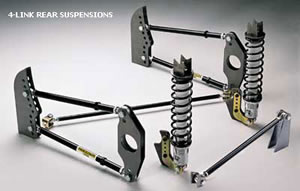 |
| This image shows a 4-link suspension upgrade kit laid out as it would be installed on an axle housing. Note the 2 sets of parallel links, the shock mounts, and the Panhard bar in the rear. |
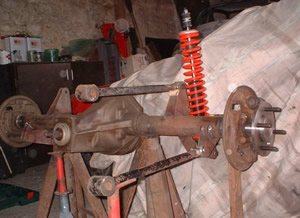 |
| Here we can see the placement of the 2 links on the near side of the axle housing. |
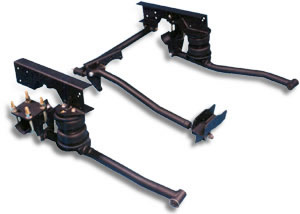 |
| Here we can see a sample 3-link layout with two links under the axle housing at each end and a center link supporting the differentail housing. |
The next type of link suspension is the three-link style. As you can probably guess, the difference between the three and four-link designs is the number of links required to locate the rear axle. Here two links are connected below the axle, one at each end. And a single upper link is connected to the top of the axle center.
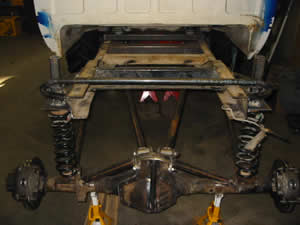 |
| This picture gives a look at an angled arm link setup. We can see the two upper links angled to provide both lateral and horizontal location of the axle housing. |
The angled arm link design is an evolution of the basic four-link setup. In an angled arm suspension, two of the four links are angled in towards the center of the vehicle. These angled arms can then located the rear axle in the lateral directions. Therefore a cumbersome Panhard bar or complicated Watt's Linkage is not necessary in an angled arm setup. The best location for the angled arms is the Satchell link design. This configuration puts the angled arms below the axle and pointing in. With a Satchell link rear suspension the designer can achieve a low roll center, good anti-squat, good support for the axle, and there is no need for extra chassis bracing. Also, the Satchell link is compact and can be squeezed into applications where other styles of live real axle could not be made to fit.
The last type of live rear axle suspension we will look at is the torque arm design. The torque arm suspension uses a long arm to absorb the rear axle torque reactions. Other links are required to locate the rear axle in the lateral and longitudinal directions and to allow for vertical displacement of the rear suspension. While the torque arm suspension was used primarily on much older vehicles, think back to the 30's, when designed properly it can still offer decent performance by today's standards.
 |
| This picture gives a look at an angled arm link setup. We can see the two upper links angled to provide both lateral and horizontal location of the axle housing. |
The design criteria for a torque arm setup are very similar to a three-link style. The most important being that the lateral location of the rear axle must be kept with a low roll center to avoid unpredictable suspension responses. In a torque arm suspension a Panhard bar or Watt's linkage is required for this task as well. The most popular style of torque arm itself is a Reese bar spring torque arm. The spring built into the Reese bar allow forces to be transferred from the axle to the chassis in a smooth and controlled manner. However, while the Reese bar is the most popular setup, other types of spring and spring material can and have been used as well. When using something less common, the important thing to remember is that when choosing the spring rate of the torque arm, the stiffness of the spring will determine how much axle rotation will occur for a given torque. Choose a spring too soft and the rear axle will tear itself from the bottom of the car, choose a spring to stiff and you will shock the chassis whenever the gas is mashed.
One last consideration built into torque arm suspensions is the concept of "decoupling". If the torque arm is connected directly to the chassis itself, then the brake torque applied to the rear axles under hard deceleration can physically lift the rear end of the car off the ground causing brake hop. Not good. The solution is to decouple the torque arm so that axle torque under braking is not transferred through the torque arm. A common way to do this is to allow the torque arm to only contact the chassis under acceleration and letting other suspension links absorb the braking torque. This works well because when the braking and acceleration functions are separated from each other, they can be optimized individually without compromise. The typical way to deal with the brake forces is to use a telescoping upper link. The upper link here is in the same location as the one found in a three-link setup. The telescoping property of the link lets it move freely in all conditions, however under braking, the link contracts on itself and bottoms out. This creates a rigid member capable of fully absorbing the brake torque of the axle.
As you can see there are plenty of variables which must be worked out to arrive at a well performing torque arm rear suspension. Not only must the lengths and placement of the suspension links be optimized, the lengths of the torque arm and telescoping arm must be determined, damping and spring rates must be optimized, and a whole slew of smaller details such as bushing spring rates and overall system preload must be found. Perhaps this is why the torque arm suspension is difficult to use in a passenger vehicle where there are so many compromises between performance and ride comfort. It becomes impractical to try and make a torque arm system work under those conditions. However in racing, where a torque arm rear end can still be found, it becomes worthwhile to spend the time and money on the necessary development to produce an optimal suspension.
*A brief note on independent rear suspensions (IRS):
It is very difficult to speak in depth about the endless production variations of IRS because there are so many. Essentially, the layout of an IRS depends on so many vehicle specific variables to the point that while two cars may have an unequal length double A-arm rear, the placement and design of the links may look nothing alike because of other design considerations. Therefore, I have tried to be as inclusive as I can about the types of production suspensions without getting mired in the details of vehicle specific suspension layouts.
Rear Wheel Drive (RWD) Rear Suspensions: Independent Rear Suspension
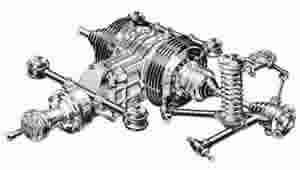 |
| This is an example of an earlier independent rear suspension. The telltale sign is the use of driveshafts instead of a solid rear axle. A close look at the suspension layout shows that this rear end is designed off of the trailing link suspension covered in the Front Suspensions article. |
Currently, nearly every manufacturer and every vehicle that has an IRS uses a different rear suspension. To the untrained eye, each of these suspensions would appear to be completely different from any other, however if we look more closely it becomes clear that the link layout and structure of these suspensions are derived from a few basic designs.
Some of the earlier IRS designs have a unique style. The Corvette and older Jaguars are two of these vehicles that have unique suspensions designed specifically for these vehicles. While each suffers its own drawbacks and offers its advantages, we won't go into that in this article as an understanding of the Corvette IRS is not pertinent to an overall understanding of the available types of rear suspensions.
Currently, with the assistance of computer modeling it has become possible to build a rear suspension around the highly effective front suspension layouts. The unequal length A-arm design, arguably the most advanced front suspension, can be found on the rear of most vehicles as well. Although not quite as recognizable in appearance as the font end of the car; when the geometry of the rear links is analyzed, it becomes apparent that in functionality the suspension operates as an unequal length A-arm design. (See the article on Types of Front Suspensions for more information on these types of designs) Since ever vehicle has its own particular design and placement of links, for simplicity's sake we will group all independent rear suspensions on rear wheel drive cars together. The chart below compares an IRS to a live axle rear suspension.
Front Wheel Drive (FWD) Rear Suspensions:
Front wheel drive cars have always had variations of front suspensions in the back. Older cars had solid rear axles and as suspension technology improved, the front and rear suspensions improved together. Most front wheel drive vehicles today have either a McPherson style rear suspension or and unequal length A-arm setup. See the article on Types of Front Suspensions for more information on these types of designs.
All-Wheel Drive (AWD) Rear Suspensions:
All-wheel drive vehicles are unique in that they have power to all four wheels and come in two different flavors from a suspension standpoint. There are predominantly RWD vehicles that send power to the front wheels and there are FWD vehicles that send power to the rear wheels. (Subarus, while being purpose built AWD, are set up more like FWD from a suspension standpoint.)
FWD oriented AWD vehicles have front and rear suspensions like FWD vehicles. The rear end suspension matches the front suspension. In today's market these suspension are either McPherson or unequal length double A-arm. (See the article on Types of Front Suspensions (link) for more information on these types of designs)
RWD oriented vehicles have an assortment of front and rear suspensions. At this point it becomes easier to discuss the suspension types based on the type of vehicle. For example, 4X4 trucks will have a live rear axle style rear suspension and depending on the age of the truck will have some style of front suspension be it A-arm, swing-arm, etc. Newer SUV's and most AWD cars will have independent rear suspension. Therefore on these vehicles there will be some variation, front and rear, of a style of suspension covered here.
Discuss this article on AutomotiveForums.com
© Copyright 2006 by AutomotiveArticles.com
Top of Page
|
|
 |
|

 AF Project Vehicle | Corporate
AF Project Vehicle | Corporate



 AF Project Vehicle | Corporate
AF Project Vehicle | Corporate

